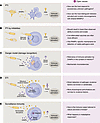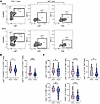Issue published August 1, 2025 Previous issue

- Volume 135, Issue 15
Go to section:
On the cover: Kidney-specific WNK1 enhances responsiveness to potassium
Boyd-Shiwarski et al. report that kidney-specific WNK1 is a scaffolding protein that organizes other proteins within biomolecular condensates called WNK bodies — structures essential for maintaining blood potassium and human health. The cover image shows immunofluorescence staining of WNK bodies (green) in the distal convoluted tubule (magenta) of a mouse kidney during hypokalemia. Image credit: Arohan Subramanya and Cary Boyd-Shiwarski.
In-Press Preview - More
Abstract
Cyclin-dependent kinase 4/6 inhibitors (CDK4/6i) have transformed the treatment landscape for hormone receptor-positive (HR+) breast cancer. However, their long-term efficacy is limited by acquired resistance, and CDK4/6i monotherapy remains ineffective in triple-negative breast cancer (TNBC). Here, we demonstrate that dual inhibition of CDK4/6 and CDK7 is a promising strategy to overcome therapeutic resistance in both HR+ and TNBC models. Kinetic analyses reveal that CDK7 inhibitors (CDK7i) primarily impair RNA polymerase II-mediated transcription rather than directly targeting cell-cycle CDKs. This transcriptional suppression attenuates E2F-driven transcriptional amplification, a key mechanism for developing CDK4/6i resistance following the degradation of the retinoblastoma protein. Consequently, combining CDK7i at minimal effective concentrations with CDK4/6i potently inhibits the growth of drug-resistant tumors. Furthermore, dual CDK4/6 and CDK7 inhibition stimulates immune-related signaling and cytokine production in cancer cells, promoting anti-tumor immune responses within the tumor microenvironment. These findings provide mechanistic insights into CDK inhibition and support the therapeutic potential of combining CDK7i with CDK4/6i for breast cancer treatment.
Authors
Sungsoo Kim, Eugene Son, Ha-Ram Park, Minah Kim, Hee Won Yang
Abstract
Toll like receptor (TLR) 7 and 9, endosomal sensors for RNA and DNA, are key mediators of autoreactivity. Although generally considered homologous, they paradoxically have opposing effects on lupus: TLR7 exacerbates disease while TLR9 protects from disease. How they mediate opposing effects in autoimmunity remains undetermined. We hypothesized that differences in signaling qualities of the Toll-Interleukin 1 Receptor (TIR) domains of TLR7 and TLR9 could be responsible for their opposing effects. To test this, we introduced the TIR domain of TLR9 into the endogenous TLR7 locus and the TLR7 TIR domain into the endogenous TLR9 locus of mice, creating chimeric molecules termed TLR779 and TLR997. Lupus-prone MRL/lpr mice carrying Tlr779 had greatly ameliorated disease while MRL/lpr mice carrying Tlr997 had markedly exacerbated disease compared to respective TlrWT mice. These experiments establish that TLR7 and TLR9 TIR domains have divergent properties and control disease quality, thus explaining the longstanding “TLR paradox.”
Authors
Claire Leibler, Kayla B. Thomas, Coralie Josensi, Russell C. Levack, Shuchi Smita, Shinu John, Daniel J. Wikenheiser, Sheldon Bastacky, Sebastien Gingras, Kevin M. Nickerson, Mark J. Shlomchik
Abstract
Despite the potential of targeted epigenetic therapies, most cancers do not respond to current epigenetic drugs. The Polycomb repressive complex EZH2 inhibitor tazemetostat was recently approved for the treatment of SMARCB1-deficient epithelioid sarcomas, based on the functional antagonism between PRC2 and SMARCB1. Through the analysis of tazemetostat-treated patient tumors, we recently defined key principles of their response and resistance to EZH2 epigenetic therapy. Here, using transcriptomic inference from SMARCB1-deficient tumor cells, we nominated the DNA damage repair kinase ATR as a target for rational EZH2 combination epigenetic therapy. We showed that EZH2 inhibition promotes DNA damage in epithelioid and rhabdoid tumor cells, at least in part via its induction of piggyBac transposable element derived 5 (PGBD5). We leveraged this collateral synthetic lethal dependency to target PGBD5-dependent DNA damage by inhibition of ATR, but not CHK1, using the ATR inhibitor elimusertib. Consequently, combined EZH2 and ATR inhibition improved therapeutic responses in diverse patient-derived epithelioid and rhabdoid tumors in vivo. This advances a combination epigenetic therapy based on EZH2-PGBD5 synthetic lethal dependency suitable for immediate translation to clinical trials for patients.
Authors
Yaniv Kazansky, Helen S. Mueller, Daniel Cameron, Phillip Demarest, Nadia Zaffaroni, Noemi Arrighetti, Valentina Zuco, Prabhjot S. Mundi, Yasumichi Kuwahara, Romel Somwar, Rui Qu, Andrea Califano, Elisa de Stanchina, Filemon S. Dela Cruz, Andrew L. Kung, Mrinal M. Gounder, Alex Kentsis
Abstract
Fibroblast growth factor homologous factors (FHFs) bind to the cytoplasmic carboxy terminus of voltage-gated sodium channels (VGSCs) and modulate channel function. Variants in FHFs or VGSCs perturbing that bimolecular interaction are associated with arrhythmias. Like some channel auxiliary subunits, FHFs exert additional cellular regulatory roles, but whether these alternative roles affect VGSC regulation is unknown. Using a separation-of-function strategy, we show that a structurally guided, binding incompetent mutant FGF13 (the major FHF in mouse heart) confers complete regulation of VGSC steady-state inactivation (SSI), the canonical effect of FHFs. In cardiomyocytes isolated from Fgf13 knockout mice, expression of the mutant FGF13 completely restores wild-type regulation of SSI. FGF13 regulation of SSI derives from effects on local accessible membrane cholesterol, which is unexpectedly polarized and concentrated in cardiomyocytes at the intercalated disc (ID) where most VGSCs localize. Fgf13 knockout eliminates the polarized cholesterol distribution and causes loss of VGSCs from the ID. Moreover, we show that the previously described FGF13-dependent stabilization of VGSC currents at elevated temperatures depends on the cholesterol mechanism. These results provide new insights into how FHFs affect VGSCs and alter the canonical model by which channel auxiliary subunits exert influence.
Authors
Aravind R. Gade, Mattia Malvezzi, Lala Tanmoy Das, Maiko Matsui, Cheng-I J. Ma, Keon Mazdisnian, Steven O. Marx, Frederick R. Maxfield, Geoffrey S. Pitt
Abstract
SLFN14-related thrombocytopenia is a rare bleeding disorder caused by SLFN14 mutations altering hemostasis in patients with platelet dysfunction. Schlafen (SLFN) proteins are highly conserved in mammals where SLFN14 is specifically expressed in megakaryocyte (MK) and erythroblast lineages. The role of SLFN14 in megakaryopoiesis and platelet function has not been elucidated. We generated a new murine model with a platelet- and MK-specific SLFN14 deletion using platelet factor-4 (PF4) cre-mediated deletion of exons 2 and 3 in Slfn14 (Slfn14;PF4-Cre) to decipher the molecular mechanisms driving the bleeding phenotype. SLFN14;PF4-Cre+ platelets displayed reduced platelet signaling to thrombin, reduced thrombin formation, increased bleeding tendency, and delayed thrombus formation as assessed by intravital imaging. Moreover, fewer in situ bone marrow MKs compared to controls. RNA sequencing and gene ontology analysis of MKs and platelets from Slfn14;PF4-Cre homozygous mice revealed altered pathways of ubiquitination, ATP activity, cytoskeleton and molecular function. In summary, we investigated how SLFN14 deletion in MKs and platelets leads to platelet dysfunction and alters their transcriptome, explaining the platelet dysfunction and bleeding in humans and mice with SLFN14 mutations.
Authors
Rachel J. Stapley, Xenia Sawkulycz, Gabriel H.M. Da Mota Araujo, Maximilian Englert, Lourdes Garcia-Quintanilla, Sophie R.M. Smith, Amna Ahmed, Elizabeth J. Haining, Nayandeep Kaur, Andrea Bacon, Andrey V. Pisarev, Natalie S. Poulter, Dean P.J. Kavanagh, Steven G. Thomas, Samantha J. Montague, Julie Rayes, Zoltan Nagy, Neil V. Morgan
View more articles by topic:
Sign up for email alerts
Review Series - More
Series edited by Ben Z. Stanger
Pancreatic Cancer
Series edited by Ben Z. Stanger
Pancreatic ductal adenocarcinoma (PDAC) has among the poorest prognosis and highest refractory rates of all tumor types. The reviews in this series, by Dr. Ben Z. Stanger, bring together experts across multiple disciplines to explore what makes PDAC and other pancreatic cancers so distinctively challenging and provide an update on recent multipronged approaches aimed at improving early diagnosis and treatment.
×

































